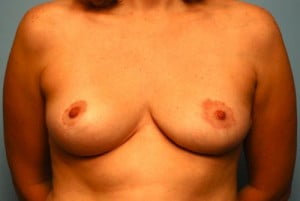About Breast Reduction Surgery in Northern Virginia
Some women find their breasts too large to suit their lifestyle. Sometimes very large breasts can also cause a variety of associated problems such as rashes, skin irritation, neck pain and back pain. Wearing bras can cause discomfort from the shoulder straps and often very large breasts can make a woman feel very self-conscious.
Breast reduction is a procedure done to reshape and reduce the size of the breasts by removing excess breast fat, glandular tissue and skin to achieve a smaller breast size in proportion with the body. Breast reduction surgery also alleviates the discomfort associated with overly large breasts.
What is the cost of breast reduction surgery around the Washington DC metro area?
The price of breast reduction in northern Virginia varies by surgeon and can sometimes be partially covered by insurance reimbursement if certain criteria are met. Read below for more detailed information about insurance coverage.
Who is a good candidate for breast reduction?
Overdeveloped breasts can have chronic negative effects for women. Common experiences of breast reduction candidates include chronic body aches and pain, especially in the back and shoulders, noticeable size difference between breasts, rashes or skin irritation from chafing, inability to enjoy sports or physical activities due to breast size, and feeling self-conscious or unhappy with breast size.
Breast reduction surgery can help to alleviate these issues, especially when the breasts are out of proportion with the body size.
Why is Dr. Hess’ Breast Reduction Surgery Superior?
The standard breast reduction surgery involves removing tissue from the lateral, superior and medial aspects of the breast. The nipple and areola are maintained on a “pedicle” of tissue that comes from the inferior part of the breast. This is the surgery that most surgeons perform.
Dr. Hess’ breast reduction technique, first championed by Dr. Elizabeth Hall-Findley of Banff, Canada, is based on a superomedial tissue pedicle. With this technique, tissue is removed from the inferior and lateral parts of the breast.
Dr. Hess finds this technique far superior for many reasons:
First, the inferior pedicle technique attempts to push the breast up from below. Structurally this is impossible as breast tissue has no supportive tissue. Dr. Hess’ technique supports the new breast from above, much like a suspension bridge.
Next, the limited blood supply of the inferior technique limits the amount of tissue able to be removed and because of potential compromise to nipple can result in nipple loss. With Dr. Hess’ technique the blood supply to the nipple is excellent and the amount of tissue to be removed is not limited. In addition there is no concern of nipple loss.
Finally, the inferior technique removes tissue from the superior part of the breast. This leaves the patient with a flat area of the upper breast which is very aesthetically unappealing. Dr. Hess’ technique leaves this tissue intact and, in fact, adds to it recreating the shape of the youthful breast.
Where are the incisions made for breast reduction surgery?
A breast reduction typically involves three incisions: one around the areola, one vertical incision from the bottom edge of the areola to the crease under the breast, and one incision beneath the breast in the crease, following its natural curve. This is commonly referred to as the “anchor” incision. Newer techniques are used to remove the lower horizontal portion, giving a “lollipop-shaped” incision.
During breast reduction surgery, the excess tissue and skin are removed and the incisions are closed with careful attention paid to the shape and overall appearance of the breasts.
How long is recovery after breast reduction?
Immediately after breast reduction surgery, most patients experience swelling and some discomfort. Dr. Hess will prescribe a pain medication to alleviate any pain or discomfort and may recommend that you wear a support bra for a few weeks.
Most patients are able to go back to work in as little as five days. It is important to remember that the full results may not be evident for several months as your body adjusts and heals.
How is breast reduction surgery covered by insurance?
In an effort to cut costs, insurance companies have progressively decided that breast reduction is usually a cosmetic procedure. Over the past 10 years, the process of approval for breast reduction has gone from a simple phone call to authorize surgery to a vast list of symptoms, procedures, and requirements.
Insurance criteria for breast reduction surgery
Symptoms:
- Pain in upper back
- Pain in neck
- Pain in shoulders
- Painful Kyphosis documented in x-ray
- Pain/discomfort/ulceration from bra straps cutting into shoulders
Criteria to meet:
- Photographic documentation confirms severe breast hypertrophy
- Patient has undergone an evaluation by physician other than the one performing the surgery, who has determined that all of the following criteria are met:
- There is reasonable likelihood that the patient’s symptoms are primarily due to the Macromastia (enlarged breasts)
- Reduction mammoplasty is likely to result in improvement of the chronic pain
- Pain symptoms persists as documented by the physician, despite at least six-month trial of therapeutic measures such as:
- Supportive devices (proper support bra, wide strap)
- Analgesic/non-steroidal anti-inflammatory drugs
- Physical therapy/exercises/posturing maneuvers
- Each insurance company provides a breast weight that must be removed from each breast in order to cover the procedure despite meeting all of the above criteria.
Women forty years of age or older are required to have a mammogram negative of cancer within the year prior to the date planned for reduction surgery.
Your results and well-being matter most to Dr. Hess
Dr. Hess approaches all of his surgeries as an artistic endeavor and breast reduction surgery is no different. In no other surgical procedure do we allow an insurance company to dictate how we should perform that procedure, where there is no artistry or aesthetic involved, only numbers. This is never how any surgery should be performed, and Dr. Hess does not wish to compromise his artistic outcomes just to meet an arbitrary number.
Hess Plastic Surgery does not participate with insurance companies. However, we will do our best to get the surgery authorized which may cover some of the expenses, such as hospital and anesthesia fees and part of the surgeon’s fee.
Consider your outcome… do you want a surgeon who just cares about meeting the numbers, or one who will make you look great?
Additional resources and information about breast reduction
- A great resource for real patient stories about breast reduction surgery can be found on RealSelf.com, where Dr. Hess has also answered hundreds of patient questions about plastic surgery.
Are you looking at multiple procedures?
Breast reduction surgery is included in the list of procedures for the Mommy Makeover.
Schedule a Consultation with Dr. Hess
If you are ready to discuss how breast reduction can help you live more comfortably and confidently, please contact us at Hess Plastic Surgery to schedule a personal consultation. Dr. Hess will discuss your goals and concerns and help you decide whether breast reduction is right for you.


